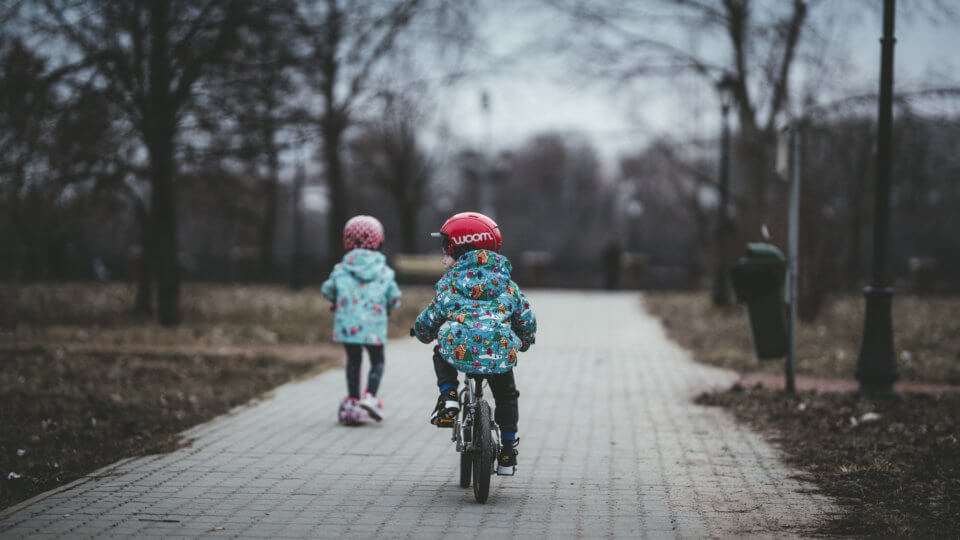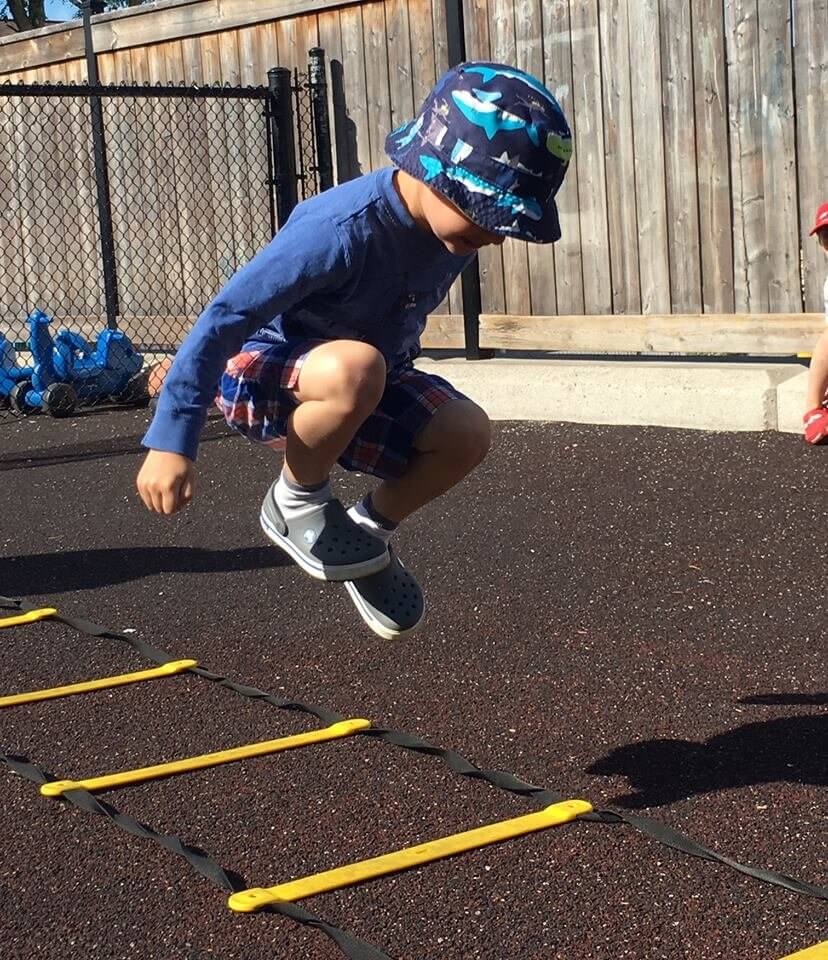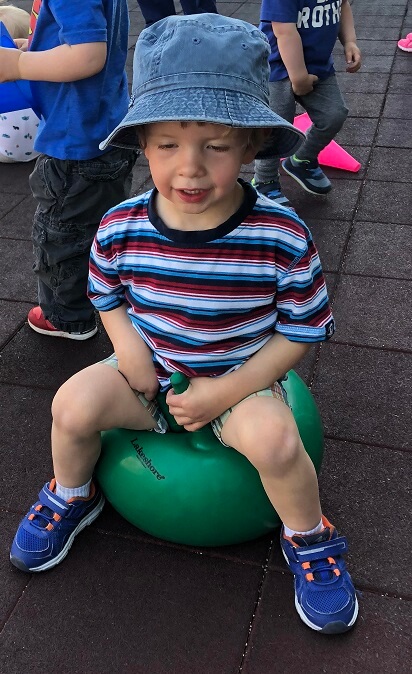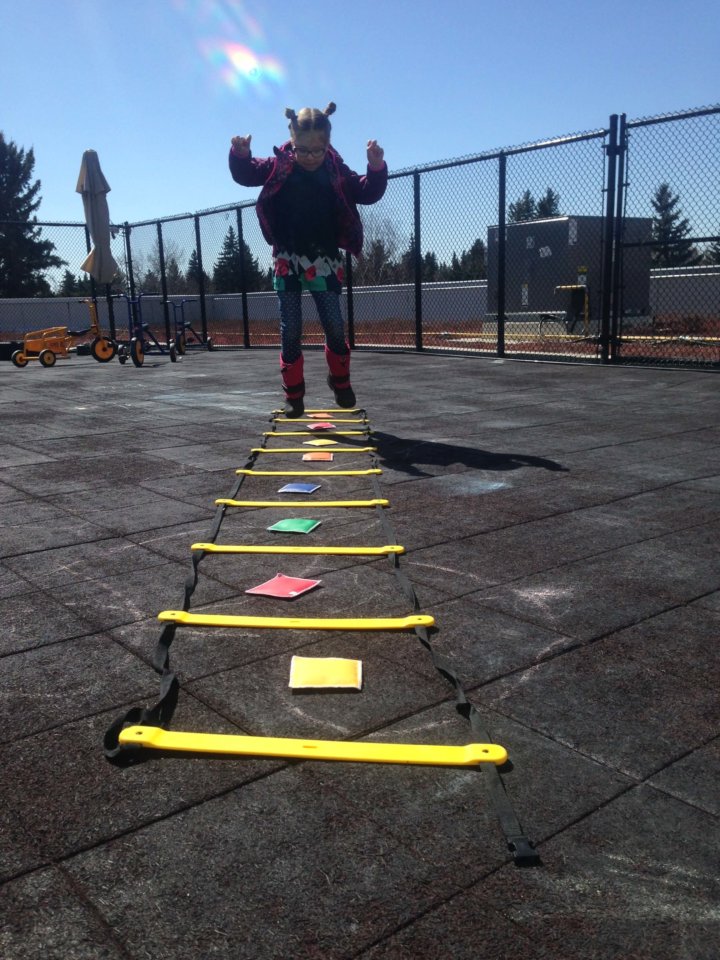Summer Camp 2025 Registration is Open – click here to register now!
Kids & Company Blog
The Importance of Physical Activity for Children

As adults, we hear all too often about the importance of participating in physical activity: going to the gym, playing sports, taking a walk, running a marathon. Sure, we all know that we SHOULD be doing it for a number of reasons — to stay healthy and fit, for our mental and physical well-being — but as parents, we often suffer from a lack of self-prioritization and getting physical activity seems to come last on our list of priorities: children, family, cooking, cleaning, work – the list goes on. We also know that it is important for our children to stay physically active, especially in the technology-focused world we currently live in (add that to the list of pressures that parent’s already have!), but do we really know why? I mean, sure, they have an abundance of energy that needs to get burnt off somehow, but they have their whole lives ahead of them to be healthy and physically fit – why put the pressure on them so early? (Especially when we are SO tired!)
I had the opportunity to chat with some incredibly insightful women — Kym Grippo, Founder and Director of LifeSports, Jennifer Comber, R.E.C.E and Director of Administration at Kids & Company, and Jackie Winters, ECE and Area Director of Edmonton Kids & Company locations — on why exactly it is so important for children to be active.
- Why is it important for children to be active?
KYM: Children are born movers. It’s hard-wired into all of our circuitry.
Did you know that active preschoolers and adolescents are better prepared to think and learn? They have better coordination, self-esteem, security, stress response and emotional health.
In addition to the physical benefits (a healthy heart and body weight, strong bones and robust muscular development), children who move more build up their biggest mental muscle, nourishing a brain that can flourish.
Did you know?
- Using both sides of the body at the same time helps with the development of motor control and coordination
- Using only one side of the body at a time aids in the development of balance because isolating each side of the body develops each side of the brain
- Being able to visually cross the midline of the body through cross-lateral movement supports later learning skills like reading and writing
Movement and physical play builds neural pathways, the building blocks through which information travels through our brains. The more neural pathways children have, the easier kids adapt to learning. Simply put, there is a strong link between the early development of locomotor skills (jumping, leaping, and running), object control (throwing, catching) and proper brain function in children. Perceptual motor experiences create the foundation for lifelong learning.
“Perceptual” refers to the intake/processing of information, while “motor” describes the end result of the movement. If preschoolers aren’t given the opportunity to jump, balance or play catch, they will be at a disadvantage cognitively because the neural pathways in the brain will have been denied the chance to grow and blossom.

Both free play and organized, evidence-based physical activity are essential to childhood development and fundamental to skill development for life.
Reading and writing are often categorized as scholastic activities, when in fact they also involve motor-based skills sets like holding a book and gripping a pencil.
In order to excel in the classroom, kids have to master doing many activities that involve using their muscles and minds collaboratively.
When their gross motor needs are met, the stage is set for academic readiness and proper behavioural patterns. It’s important for kids to be exposed to a variety of perceptual-motor experiences, to give each child the opportunity to reach their own unique potential.
- What are the effects of exercise on children physically, as well as mentally?
KYM: The effects of exercise are powerful. In fact, the health benefits for active preschoolers go way beyond fitness. While science has proven the link between academic performance and exercise, things don’t stop there.
Cognitively, exercise also impacts our children’s ability to reason, function, focus, relax and sleep better. Being active helps manage anxiety and moods. Exercising releases happy hormones. Happy hormones mean happy kids. Physical activity improves one’s attention span, creativity and enhances self-control, awareness skills and provides a sense of comfort and well-being. Exercise improves children’s memories, boosts their test results and supports their problem-solving skills.
Physically, getting the blood pumping makes the brain function at its peak because exercise increases levels of important neurotransmitters like dopamine and serotonin, and norepinephrine which mobilize the brain and the body for action. That’s the key to physical literacy…building and conditioning the brain and the body together. Additionally, physical benefits include improved cardiorespiratory fitness, strong bones, muscle growth, a sound physique and the groundwork laid for a love of staying active for life.

- What types of activity are important for different age groups?
KYM: There is a considerable amount of detail that can be expanded upon based on age and ability, but on a very basic level, it would be as follows:
Infant to Baby (birth–6 months):
- Peekaboo type play assists in memory for objects and people
- Rhymes and songs for a lyrical, comforting repetitive chant
- Shaker toys that make noise to encourage reaching for new objects
- Rocking and jumping games (bouncing baby on lap to music)
- Cuddling, feeling touch, hearing a parental voice for security
- Baby massage for calming and soothing
Toddler:
- Establishing routines for various times of the day such as bedtime, bath and meals
- Movement games (dancing to music, playing Simon Says)
- Language activities done in verse, nursery rhymes
- Making animal noises to matching pictures
- Fingerplay to songs like Eensy Weensy Spider
- Dress Up
- Pretend play – make-believe, sensory games
- Creative activities – paint, crayons, paper (hand-eye co-ordination/fine motor)
- Sorting by shape, texture, size and colour
Preschool:
- Playing Dress Up
- Active games that use perceptual motor skills such as leaping, sliding, galloping, running, hopping and jumping
- Object control activities like catching, throwing, dribbling, rolling and kicking
- Sharing and understanding feelings
- Regular reading, storytelling and language games
School Age:
- Gift child as a special helper
- Play exploration and perceptual-motor skills games
- Arts and crafts
- Letter and number games for simple adding and spelling
- Basic cooking to learn measuring, mixing and time

- What is the impact of technology on children’s physical activity?
KYM: In this techno-focused, digitally-driven age, it’s easy to lose sight of our need to sit less and move more. Where it used to be the norm for children to walk, skateboard, skip or bike to school, they are now driven by bus or car. The electronic age is here to stay and with it a monopoly on those who are using the devices getting younger and younger.
The meaning of the word “mobile” has undergone a 21st-century shift. Our previously ‘mobile’ bodies have been replaced with ‘mobile’ gizmos and gadgets instead. While turning off the electronics isn’t always easy, it is necessary, in order for families to make room for more physical play in their day.
As far as the data plays out, Canadian kids are still getting an alarming D+ on their overall physical activity.*
*2018 ParticipACTION Report Card on Physical Activity for Children and Youth
In our rush to always do more in less time, it’s important to remember there is a way to fit physical activity into our family life because only sixty-two percent of 3 to 4-year-olds are attaining the recommended amount of daily activity for their age group.* That leaves a thirty-eight percent margin for improvement.
Meanwhile, a whopping seventy-six percent of 3 to 4-year-olds are spending too much time interacting with screens.** As they get older, the numbers plummet further as our youth become even less active. Just thirty-five per cent of 5 to 17-year-old’s fall within the recommended amount of physicality for their age groups*, creating an opportunity for sixty-five per cent of adolescents to better the stats. Just over half, or fifty-one percent of 5 to 17-year-olds are overdosing on digital usage.**
* 2018 Canadian 24 – Hour Movement Guidelines for Children and Youth
** Canadian 24-Hour Movement Guidelines for recreational screen-based sedentary behaviours.
ABOUT OUR CONTRIBUTORS:
Kym Grippo: Kym Grippo's positive approach to solving tough problems has changed the way companies view physical activity and the impact it has on their productivity and satisfaction as a result. As the Founder of LifeSports, Kym specializes in bringing health and wellness business’ to life through video. With the personal motto 'Changing the way the world plays every day,' this high-energy professional has embraced her background in television, media production and fitness to help active living brands get great results. Mom to two boys, in her spare time this New Balance Ambassador loves travelling and spending time with her family.
Jennifer Comber: Jennifer Comber has been on the Kids & Company team since 2005. She started off working in an infant room and has grown into our Director of Administration! Jennifer resides in Whitby with her husband and four children.
Jackie Winters: Jacqueline (Jackie) Winters is the Area Director for the Edmonton Area centres. She holds a Bachelor of Education with a minor in special needs. Jackie has a large, beautiful family with five children who like to travel and go for long walks. If she is able to find a bit of quiet time for herself you can likely find her scrapbooking.
This is Part 1 of a 2 Part blog series on the Importance of Physical Activity in Children. Stay Tuned for Part 2.
Don't forget to follow us on Facebook, Instagram and Twitter!
Posted on: Thursday September 19th, 2019
Posted by: Brittany Kostiuk
Calgary
Calgary
Calgary
Calgary
Calgary
Edmonton
Cochrane
Red Deer
Calgary
Calgary
Okotoks
Calgary
Calgary
Calgary
Calgary
Edmonton
St. Albert
Edmonton
Edmonton
Edmonton
Edmonton
Edmonton
Edmonton
Edmonton
St. Albert
Edmonton
Edmonton
Sylvan Lake
Edmonton
Sherwood Park
Edmonton
Calgary
Edmonton
Calgary
Edmonton
Kamloops
Langley
Langley
New Westminster
North Vancouver
Richmond
Vancouver
Victoria
Victoria
Port Moody
Surrey
Surrey
Surrey
North Vancouver
Nanaimo
Surrey
Coquitlam
Burnaby
Port Coquitlam
Vancouver
Maple Ridge
Maple Ridge
Maple Ridge
Mission
Maple Ridge
Maple Ridge
Maple Ridge
Maple Ridge
Mission
Mission
Maple Ridge
Maple Ridge
Chicago
Chicago
Chicago
Chicago
Schaumburg
Chicago
Winnipeg
Abington
Canton
Quincy
West Quincy
Braintree
Braintree
Walpole
East Walpole
Brighton
Brookline
Jamaica Plain
Jamaica Plain
Cambridge
Needham
Newton Highlands
Newton
Cambridge
Boston
Randolph
Kingston
St. Peters
Lake St. Louis
Troy
O'Fallon
St. Charles
Lake St. Louis
St. Peters
O'Fallon
Howell Township
Freehold Township
Manalapan Township
Stratford
Marlton
West Deptford
Bedford
Dartmouth
Halifax
Bedford
Hammonds Plains
Lower Sackville
Eastern Passage
Avon Lake
Beachwood
Hudson
Medina
Strongsville
Cleveland
Westlake
Aurora
Burlington
Burlington
Etobicoke
Etobicoke
Hamilton
London
Milton
Mississauga
Ottawa
Richmond Hill - Corporate office (No child care services)
Toronto
Toronto
Toronto
Toronto
Toronto
Waterloo
Kanata
Oakville
Oakville
Toronto
Whitby
Toronto
Mississauga
Ottawa
Toronto
Toronto
Toronto
Brampton
Stoney Creek
Toronto
Nepean
Burlington
Burlington
Oakville
Waterdown
Oakville
Pittston
Wilkes-Barre
Exeter
Old Forge
Dover
Harrisburg
Harrisburg
Harrisburg
Hummelstown
Palmyra
York
York
York
Sweet Kiddles Avon Lake, part of the Kids & Company Family
Abington
Aurora
Sweet Kiddles Beachwood, part of the Kids & Company Family
Bedford (Dellridge Lane)
Larry Uteck (Southgate Dr)
Pine Village South End, by Kids & Company
Braintree 1
Braintree 2
Brampton
Pine Village Brighton, by Kids & Company
Pine Village Brookline, by Kids & Company
Burlington Children’s Centre
Burloak
Appleby
Beacon Hill
Brightstart Burnaby, by Kids & Company
Bow Trail
Livingston
Midlake
Millrise
Royal Oak
Britannia Crossing
Marda Loop
Evanston
Beltline
Aviation Crossing
Gulf Canada Square
Royal Oak Out of School Care and Child Care
Glendeer: New – Open for Enrollment
Pine Village Kendall Square, by Kids & Company
Pine Village Porter Square, by Kids & Company
Canton
Jackson
Lincoln Park
Harrison
West Loop
Fulton
Sweet Kiddles University Circle, part of the Kids & Company Family
Cochrane
Brightstart Coquitlam, by Kids & Company
Dartmouth
Dover
Walpole North
Eastern Passage
Ellerslie
Edmonton Ice District
Baturyn
Diamond
Friendly Frog
Meadowlark Park
St. Charles
St. Dominic
Sunshine Factory
Tamarack
Jagare Ridge
Horse Hill
Fraser
Century Park: New – Open for Enrollment
Grandview Heights: New – Open for Enrollment
Islington
Etobicoke (Bloor & Islington)
ABC Kiddie Kampus Exeter, by Kids & Company
Apple Hill Academy Freehold by Kids & Company
Halifax
Hamilton
Hammonds Plains
Route 39
Schaffner
Swatara
Apple Hill Academy Howell by Kids & Company
Sweet Kiddles Hudson, part of the Kids & Company Family
Hummelstown
Pine Village JP Revere, by Kids & Company
Pine Village JP South Street, by Kids & Company
Kamloops
Eagleson (South Kanata)
Crayon College, by Kids & Company
Tyke Town Lake St. Louis, by Kids & Company
ABC Lake St. Louis, by Kids & Company
Kids World
Langley (200th St.)
London Richmond
Sackville
Apple Hill Academy Manalapan by Kids & Company
119 Avenue, Part of the Kids & Company Family
Dewdney House (Infant/Toddler and 3-5), Part of the Kids & Company Family
Dewdney Church (Preschool/OSC/3-5), Part of the Kids & Company Family
Edge, Part of the Kids & Company Family
Webster’s Corner, Part of the Kids & Company Family
Harry Hooge, Part of the Kids & Company Family
Alouette, Part of the Kids & Company Family
Silver Valley, Part of the Kids & Company Family
Whonnock, Part of the Kids & Company Family
Under The Sun Marlton, part of the Kids & Company Family
Sweet Kiddles Medina, part of the Kids & Company Family
Milton
Lougheed, Part of the Kids & Company Family
Stave Falls, Part of the Kids & Company Family
Briskham, Part of the Kids & Company Family
Robert Speck Parkway
Mississauga Gateway Centre
Nanaimo
Pine Village Needham, by Kids & Company
Ottawa Barrhaven
New Westminster
Pine Village West Newton, by Kids & Company
Pine Village Newton Highlands, by Kids & Company
North Vancouver
North Van Esplanade
O’Fallon South
ABC O’Fallon, by Kids & Company
Oakville Cornwall
Oakville Dundas
Joshua Creek
Oakville West (3471 Wyecroft Rd)
Okotoks
ABC Kiddie Kampus Old Forge, by Kids & Company
Ottawa Albert
Ottawa Westboro
Palmyra
ABC Kiddie Kampus Pittston, by Kids & Company
Brightstart Port Coquitlam, by Kids & Company
Port Moody
Marina Bay
Randolph
Red Deer
Richmond
Head Office
Schaumburg
Sherwood Park
St. Albert North
St. Albert Grandin
ABC St. Charles, by Kids & Company
Tyke Town St. Peters, by Kids & Company
ABC St. Peters, by Kids & Company
Stoney Creek
Under The Sun Stratford, part of the Kids & Company Family
Sweet Kiddles Strongsville, part of the Kids & Company Family
Morgan Crossing
Surrey Professional Centre
King George
Brightstart Cloverdale, by Kids & Company
Sylvan Lake
Bloor Christie
Bloor (Bloor St. East)
Consumers
Finch
Front
Scotia Plaza
Stockyards
St. Andrew’s Church
Liberty Village
Rosedale
Queen West
Tyke Town Troy, by Kids & Company
Vancouver West
Cambie
Langford
Victoria
Walpole South
Waterdown
Tech Town
Under The Sun West Deptford, part of the Kids & Company Family
West Quincy
Sweet Kiddles Westlake, part of the Kids & Company Family
Whitby
ABC Kiddie Kampus East Mountain, by Kids & Company
Winnipeg
West York
Queen Street
Keystone Early Learning Academy, part of the Kids & Company Family
Calgary
Calgary
Calgary
Calgary
Calgary
Edmonton
Cochrane
Red Deer
Calgary
Calgary
Okotoks
Calgary
Calgary
Calgary
Calgary
Edmonton
St. Albert
Edmonton
Edmonton
Edmonton
Edmonton
Edmonton
Edmonton
Edmonton
St. Albert
Edmonton
Edmonton
Sylvan Lake
Edmonton
Sherwood Park
Edmonton
Calgary
Edmonton
Calgary
Edmonton
Kamloops
Langley
Langley
New Westminster
North Vancouver
Richmond
Vancouver
Victoria
Victoria
Port Moody
Surrey
Surrey
Surrey
North Vancouver
Nanaimo
Surrey
Coquitlam
Burnaby
Port Coquitlam
Vancouver
Maple Ridge
Maple Ridge
Maple Ridge
Mission
Maple Ridge
Maple Ridge
Maple Ridge
Maple Ridge
Mission
Mission
Maple Ridge
Maple Ridge
Chicago
Chicago
Chicago
Chicago
Schaumburg
Chicago
Winnipeg
Abington
Canton
Quincy
West Quincy
Braintree
Braintree
Walpole
East Walpole
Brighton
Brookline
Jamaica Plain
Jamaica Plain
Cambridge
Needham
Newton Highlands
Newton
Cambridge
Boston
Randolph
Kingston
St. Peters
Lake St. Louis
Troy
O'Fallon
St. Charles
Lake St. Louis
St. Peters
O'Fallon
Howell Township
Freehold Township
Manalapan Township
Stratford
Marlton
West Deptford
Bedford
Dartmouth
Halifax
Bedford
Hammonds Plains
Lower Sackville
Eastern Passage
Avon Lake
Beachwood
Hudson
Medina
Strongsville
Cleveland
Westlake
Aurora
Burlington
Burlington
Etobicoke
Etobicoke
Hamilton
London
Milton
Mississauga
Ottawa
Richmond Hill - Corporate office (No child care services)
Toronto
Toronto
Toronto
Toronto
Toronto
Waterloo
Kanata
Oakville
Oakville
Toronto
Whitby
Toronto
Mississauga
Ottawa
Toronto
Toronto
Toronto
Brampton
Stoney Creek
Toronto
Nepean
Burlington
Burlington
Oakville
Waterdown
Oakville
Pittston
Wilkes-Barre
Exeter
Old Forge
Dover
Harrisburg
Harrisburg
Harrisburg
Hummelstown
Palmyra
York
York
York
Sweet Kiddles Avon Lake, part of the Kids & Company Family
Abington
Aurora
Sweet Kiddles Beachwood, part of the Kids & Company Family
Bedford (Dellridge Lane)
Larry Uteck (Southgate Dr)
Pine Village South End, by Kids & Company
Braintree 1
Braintree 2
Brampton
Pine Village Brighton, by Kids & Company
Pine Village Brookline, by Kids & Company
Burlington Children’s Centre
Burloak
Appleby
Beacon Hill
Brightstart Burnaby, by Kids & Company
Bow Trail
Livingston
Midlake
Millrise
Royal Oak
Britannia Crossing
Marda Loop
Evanston
Beltline
Aviation Crossing
Gulf Canada Square
Royal Oak Out of School Care and Child Care
Glendeer: New – Open for Enrollment
Pine Village Kendall Square, by Kids & Company
Pine Village Porter Square, by Kids & Company
Canton
Jackson
Lincoln Park
Harrison
West Loop
Fulton
Sweet Kiddles University Circle, part of the Kids & Company Family
Cochrane
Brightstart Coquitlam, by Kids & Company
Dartmouth
Dover
Walpole North
Eastern Passage
Ellerslie
Edmonton Ice District
Baturyn
Diamond
Friendly Frog
Meadowlark Park
St. Charles
St. Dominic
Sunshine Factory
Tamarack
Jagare Ridge
Horse Hill
Fraser
Century Park: New – Open for Enrollment
Grandview Heights: New – Open for Enrollment
Islington
Etobicoke (Bloor & Islington)
ABC Kiddie Kampus Exeter, by Kids & Company
Apple Hill Academy Freehold by Kids & Company
Halifax
Hamilton
Hammonds Plains
Route 39
Schaffner
Swatara
Apple Hill Academy Howell by Kids & Company
Sweet Kiddles Hudson, part of the Kids & Company Family
Hummelstown
Pine Village JP Revere, by Kids & Company
Pine Village JP South Street, by Kids & Company
Kamloops
Eagleson (South Kanata)
Crayon College, by Kids & Company
Tyke Town Lake St. Louis, by Kids & Company
ABC Lake St. Louis, by Kids & Company
Kids World
Langley (200th St.)
London Richmond
Sackville
Apple Hill Academy Manalapan by Kids & Company
119 Avenue, Part of the Kids & Company Family
Dewdney House (Infant/Toddler and 3-5), Part of the Kids & Company Family
Dewdney Church (Preschool/OSC/3-5), Part of the Kids & Company Family
Edge, Part of the Kids & Company Family
Webster’s Corner, Part of the Kids & Company Family
Harry Hooge, Part of the Kids & Company Family
Alouette, Part of the Kids & Company Family
Silver Valley, Part of the Kids & Company Family
Whonnock, Part of the Kids & Company Family
Under The Sun Marlton, part of the Kids & Company Family
Sweet Kiddles Medina, part of the Kids & Company Family
Milton
Lougheed, Part of the Kids & Company Family
Stave Falls, Part of the Kids & Company Family
Briskham, Part of the Kids & Company Family
Robert Speck Parkway
Mississauga Gateway Centre
Nanaimo
Pine Village Needham, by Kids & Company
Ottawa Barrhaven
New Westminster
Pine Village West Newton, by Kids & Company
Pine Village Newton Highlands, by Kids & Company
North Vancouver
North Van Esplanade
O’Fallon South
ABC O’Fallon, by Kids & Company
Oakville Cornwall
Oakville Dundas
Joshua Creek
Oakville West (3471 Wyecroft Rd)
Okotoks
ABC Kiddie Kampus Old Forge, by Kids & Company
Ottawa Albert
Ottawa Westboro
Palmyra
ABC Kiddie Kampus Pittston, by Kids & Company
Brightstart Port Coquitlam, by Kids & Company
Port Moody
Marina Bay
Randolph
Red Deer
Richmond
Head Office
Schaumburg
Sherwood Park
St. Albert North
St. Albert Grandin
ABC St. Charles, by Kids & Company
Tyke Town St. Peters, by Kids & Company
ABC St. Peters, by Kids & Company
Stoney Creek
Under The Sun Stratford, part of the Kids & Company Family
Sweet Kiddles Strongsville, part of the Kids & Company Family
Morgan Crossing
Surrey Professional Centre
King George
Brightstart Cloverdale, by Kids & Company
Sylvan Lake
Bloor Christie
Bloor (Bloor St. East)
Consumers
Finch
Front
Scotia Plaza
Stockyards
St. Andrew’s Church
Liberty Village
Rosedale
Queen West
Tyke Town Troy, by Kids & Company
Vancouver West
Cambie
Langford
Victoria
Walpole South
Waterdown
Tech Town
Under The Sun West Deptford, part of the Kids & Company Family
West Quincy
Sweet Kiddles Westlake, part of the Kids & Company Family
Whitby
ABC Kiddie Kampus East Mountain, by Kids & Company
Winnipeg
West York
Queen Street
Keystone Early Learning Academy, part of the Kids & Company Family





